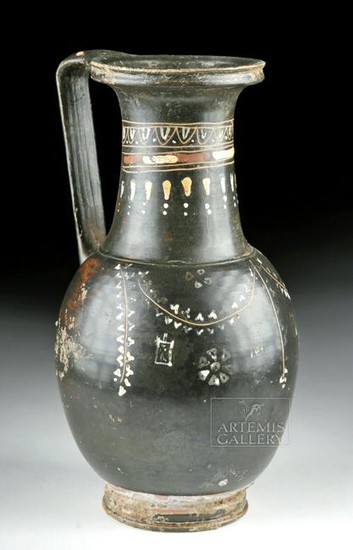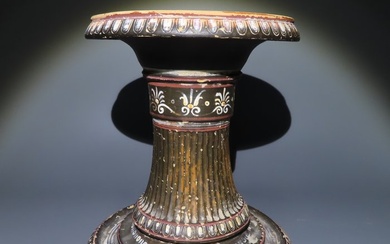Greek Apulian / Gnathian Blackware Olpe - Maker's Mark
**Originally Listed At $1000**
Magna Graecia, southern Italy, Apulia, Gnathian, ca. 325 BCE. A beautiful example of the funerary pottery made in southern Italy when it was part of the Greek colonial sphere. A lovely olpe, with an ovoid bulbous body rising to a tubular neck that flares to a collared rim with a strap handle joining rim to shoulder - all upon a tiered foot with a maker's mark on the base in the form of a large red cross. This is an example of Gnathian ware, distinguished by its colorful decoration - budded garlands and stylized floral motifs adorning the body, and decorative registers on the neck featuring from top to bottom: an egg and dart motif, repeated lozenge-shaped 'beads', and dotted strokes - all in fugitive red, white, and yellow pigments applied directly to a lustrous black glaze. Size: 7.75" H (19.7 cm)
Gnathia ware is named for the site where it was first discovered - the Apulian site of Egnathia (also Gnatia, Egnatia, Ignazia). The black glaze ware is traditionally decorated with floral and other decorative motifs in red, white, and/or yellow hues. Scholars believe that its production most likely was centered around Taras, with primary workshops in Egnathia and Canosa. The quantity and quality of Greek colonial Apulian potters increased significantly following the Peloponnesian War when Attic exports dramatically decreased. Apulian artistry demonstrates influences of Ionian (Athenian, Attic) conventions, as well as Doric (western colonial Greek) styles, with a palpable native Italian aesthetic.
Provenance: private East Coast, USA collection; ex-Frances Artuner collection, Belgium, acquired in the 1960s
All items legal to buy/sell under U.S. Statute covering cultural patrimony Code 2600, CHAPTER 14, and are guaranteed to be as described or your money back.
A Certificate of Authenticity will accompany all winning bids.
We ship worldwide to most countries and handle all shipping in-house for your convenience.
#144086
Condition Report: Normal surface wear with scuffs and some pigment loss as shown. Areas of encrustation on the body and base as shown. Otherwise intact and quite lovely.
View it on
Estimate
Time, Location
Auction House
**Originally Listed At $1000**
Magna Graecia, southern Italy, Apulia, Gnathian, ca. 325 BCE. A beautiful example of the funerary pottery made in southern Italy when it was part of the Greek colonial sphere. A lovely olpe, with an ovoid bulbous body rising to a tubular neck that flares to a collared rim with a strap handle joining rim to shoulder - all upon a tiered foot with a maker's mark on the base in the form of a large red cross. This is an example of Gnathian ware, distinguished by its colorful decoration - budded garlands and stylized floral motifs adorning the body, and decorative registers on the neck featuring from top to bottom: an egg and dart motif, repeated lozenge-shaped 'beads', and dotted strokes - all in fugitive red, white, and yellow pigments applied directly to a lustrous black glaze. Size: 7.75" H (19.7 cm)
Gnathia ware is named for the site where it was first discovered - the Apulian site of Egnathia (also Gnatia, Egnatia, Ignazia). The black glaze ware is traditionally decorated with floral and other decorative motifs in red, white, and/or yellow hues. Scholars believe that its production most likely was centered around Taras, with primary workshops in Egnathia and Canosa. The quantity and quality of Greek colonial Apulian potters increased significantly following the Peloponnesian War when Attic exports dramatically decreased. Apulian artistry demonstrates influences of Ionian (Athenian, Attic) conventions, as well as Doric (western colonial Greek) styles, with a palpable native Italian aesthetic.
Provenance: private East Coast, USA collection; ex-Frances Artuner collection, Belgium, acquired in the 1960s
All items legal to buy/sell under U.S. Statute covering cultural patrimony Code 2600, CHAPTER 14, and are guaranteed to be as described or your money back.
A Certificate of Authenticity will accompany all winning bids.
We ship worldwide to most countries and handle all shipping in-house for your convenience.
#144086
Condition Report: Normal surface wear with scuffs and some pigment loss as shown. Areas of encrustation on the body and base as shown. Otherwise intact and quite lovely.





